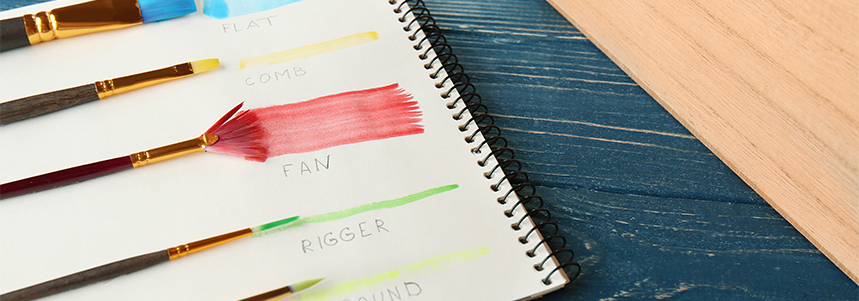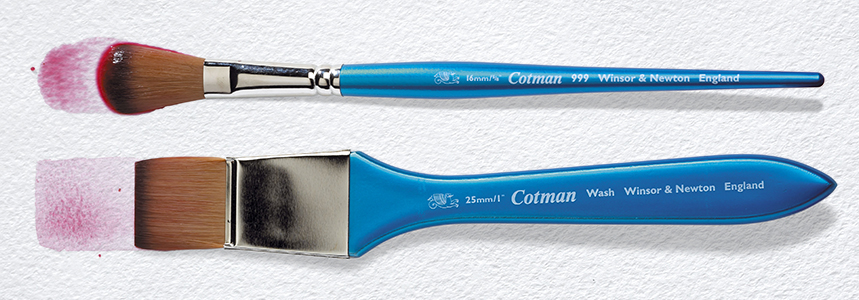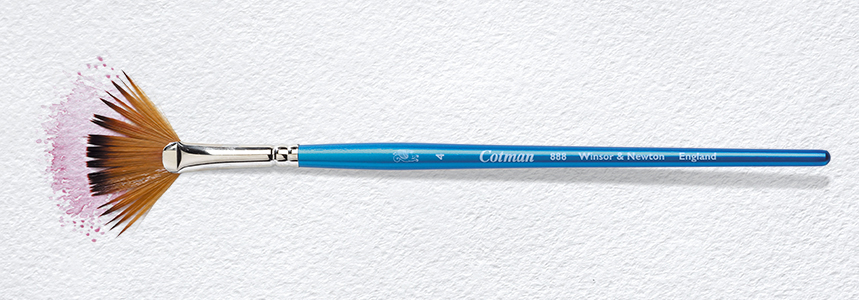£5 OFF Orders over £50 | Use Code 585C
Watercolour Brushes

Natural hair brushes are always a firm favourite with watercolourists, but recent developments in synthetic technology mean that there are more brush options available than ever before! Whether you're looking for a natural or synthetic hair brush there is bound to be the perfect brush for you. Find some handy hints and tips below to help you choose your ideal painting tool.
It is of the utmost importance to watercolour artists that their brushes are able to create the large, dilute washes associated with the mediums; so perhaps the most important quality of any watercolour brush is its ability to carry vast amounts water. It is widely considered that a natural hair brush will be superior to a synthetic; although recent research into synthetics has produced brushes that put up a considerable contest! When it comes to choosing your brush, it is not only the type of hair you must consider, but also its shape. Below you will find some hints and tips that will help you select the brush that is the best for you!
Natural or synthetic hair?
It is widely said that natural hair brushes are the best choice for watercolour painting, with sable being the best of the bunch. Over the years there have been great leaps in the manufacturing of synthetics that has resulted in man-made fibres that are able to mimic the properties of their natural counterparts. Artists that wish to avoid using animal-derived products in their art now have more choice than ever when it comes to selecting a new brush. Of course there are benefits to using both.
Natural Hair
Animal hair has an organic structure that is naturally conducive to watercolour painting. Each tiny fibre is built up from tiny scales which in nature would help to keep the animal warm. These scales greatly increase the surface area of the hair and naturally trap any moisture. This is particularly beneficial for watercolour painting; when tightly packed into a brush tip these scales can retain vast amounts of water and paint which results in the colour carrying capacity that natural hair is renowned for. Natural hair brushes are also commonly taper-dressed, which is where different lengths of hair are carefully rolled and shaped to form a fine point.
A variety of natural hairs can be found in the manufacture of watercolour brushes. Sable is perhaps the most sought after and is considered to be the superior natural hair. Made from the pelt of the Siberian Kolinsky (Mustela Siberica Siberica), true sable is known for its durability and strength. It should be noted that not all sable brushes are made equal! The finest sable is sourced from the winter pelt of the male animal; lesser quality sables will be made from inferior parts of the pelt. You may also find that to keep costs down, some manufacturers will also include female sable hair in their brushes. Sables can also be named to reflect the area in which the hair was gathered; Tajmyr, for example is an area of Siberia where extraordinarily good sable hair is known to be harvested and brushes made using this hair will be marketed as Kolinsky-Tajmyr. Sables hold sharp points and create crisp lines; they also have a good degree of snap which is great for creating expressive, powerful marks.
You will often see Squirrel hair used in wash brushes, sometimes referred to as 'Petit Gris'. Some squirrel brushes will also be described as being 'Kazan'; this refers to the area of Russia in which the hair was harvested and is considered to be the best quality. These brushes have a large belly and taper towards the end to form a fne point. Squirrel hair is the most popular choice for these brushes as it is naturally fine; the finer hair allows more filaments to be packed into the brush head, and more hair means an even better colour carrying capacity, which is exactly what you need from a wash brush! A traditional 'three-knot' quill binding technique is commonly used for wash brushes, which draws from the trusted techniques of the past. Squirrel hair is soft and flexible, and does not have the same snap as a Sable brush. While this property makes them the perfect match for large washes it does mean that they are not ideal for crisp, dramatic marks.
Although less common you may also come across Goat hair, which is an inexpensive natural hair that is widely available. Soft and resilient, this hair is most commonly used for wash brushes and also in Ron Ranson's Hake brush.
Synthetic
Unlike their natural hair counterparts, synthetic fibres are not made up from individual scales. This once meant that the colour carrying capacity of a synthetic brushes was considerably less, but synthetic developments have come so far that they can stand up to challenge natural hair. One distinct difference between synthetics and sable is their durability; synthetic filaments are much stronger than natural hair and will stand up to much more use and abuse especially if there are being used daily. Providing they are cared and cleaned for properly, they can have a considerably longer lifespan. Synthetic fibres also offer more snap and control and are often popular with artists who work in fine detail or prefer finer, crisper marks. Artists' quality synthetic brushes are usually made from man-made fibres of different widths and lengths - this variation in size and shape aims to mimic the taper-dressing process used to made natural hair brushes.
Natural-Synthetic Mixes
Natural-Synthetic mixes are also available; by using a mixture of hairs, costs can be kept to an economical level. These brushes will also have the benefits of both sable and synthetic brushes. The sable hair will greatly enhance the colour carrying capacity of the brush, and the sable will add an extra level of durability. Some popular synthetic-sable mixes include the Winsor & Newton Sceptre Gold and Pro-Arte Connoisseur ranges.
Watercolour Brush Shapes
Having a varied selection of brush shapes and sizes in your collection will greatly open up the mark making techniques available to you.
Round

A round profile brush is made up of a cylinder of hairs that taper to a point. They are perhaps the most popular shape and are suitable for a range of techniques, from fine detail to large washes.
Rigger

Rigger brushes have much longer hair than any other type of brush. Tapered to a fine point, these long hairs are ideal for painting long, fine lines. In fact their name is derived from the 'rigging' they are commonly used to paint!
Flat

Flat brushes are made from hair arranged with sharp square-edges. These edges are brilliant for creating washes or for making bold, geometric strokes.
Wash & Mop

A mop brush is a large round, or quill shaped brush that is used for depositing large washes of colour. Their large belly is shaped specifically to hold a generous amount of colour. Flat wash brushes can also be used, but their hair is arranged differently.
Filbert

A Filbert brush features hairs that are arranged in a flat, rounded formation. Their oval shaped profile provides a rounded mark that can be used to blend or even create flower petals.
Fan

Fan brushes are made from hair that is made into a canopy-like shape. Ideal or a variety of special effects, fan brushes can also be used for blending, softening edges or adding texture to your work.
Special Effects
We also stock a range of unique watercolour brushes made in unusual shapes that are brilliant for certain textures and techniques. The Terry Harrison Masterstroke range and also some brushes from the Da Vinci range offer unique brush tip shapes that are great for creating anything from branches and leaves to furry textures.
It is absolutely paramount that artists take care of their tools. It is particularly important with regards to brushes, as a properly cared for brush can last a lifetime, providing it is of good quality. There are some general brush-care tips that you should follow:
Always clean your brush at the end of a painting session.
Do not leave brushes soaking in water.
Never leave them resting on their heads or tufts.
Shape the head after cleaning and do not point them in your mouth!
For a more thorough description of the brush cleaning and caring process, see our handy instructions below!
Caring for your Watercolour Brushes
Make sure that your brushes are kept out of direct sunlight.
If your brushes are going to be in storage for any length of time make sure that they are clean and perfectly dry before putting them away in an airtight box.
Moth repellents are recommended when storing brushes, but can not be relied upon as a sure preventative measure against moth damage.
Be sure to follow the instructions below when you clean your brush! The most common cause of a poorly-pointing brush is the build up of pigment particles in the base of the brush. If these particles are allowed to build up they simply push the hairs apart from one another and prevent a point from forming.
Cleaning your Watercolour Brushes
Brushes should be wiped clean on a lint-free rag and then rinsed under running water.
Gently clean the brushes with cool water and mild soap and carefully swirl the soapy brush in the palm of your hand.
Repeat steps one and two until the soap and the water run clear. It's amazing how much colour can be trapped in the brush tip, so take time to make sure that all of it is clean.
Some watercolour pigments may cause the brush to stain, but this will not effect the performance or the life of the hair.
Gently reshape the brush head and remove any excess water.
Dry the handle and ferrule and lie on a flat surface until the hair is dry. Once the brush is completely dry you can stand the brush up in a jar or brush holder. It is important that the brush is not left vertically until it is fully dry. Any water present in the tip when stored vertically can cause the adhesive in the ferrule to rot and consequently lessen the life of your brush.
Restoring a 'hooked' Synthetic Brush
Synthetic filaments sometimes have a tendency to become bent or 'hooked'. This obviously creates problems for artists as it prevents a perfect point from forming, which can make it difficult to create fine lines and details. Should this 'hooking' occur, the synthetic filament can sometimes be straightened by holding the brush head for one or two minutes in water which has boiled and cooled slightly. Once dipped, remove any excess water, shape the brush and apply a Gum Arabic solution. Leave the brush to dry and wash before use.











